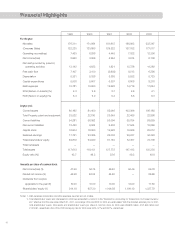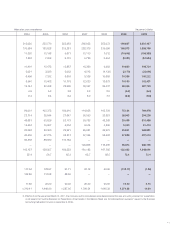Alpine 2009 Annual Report Download - page 20
Download and view the complete annual report
Please find page 20 of the 2009 Alpine annual report below. You can navigate through the pages in the report by either clicking on the pages listed below, or by using the keyword search tool below to find specific information within the annual report.20
As a result of the changing the classification, in comparison to the previous
accounting method, cost of sales increased by ¥99 million (US$1,008
thousand) and gross margin decreased by same amount and operating
loss and loss before income taxes and minority interests were no impact.
(7) Property, plant, equipment and depreciation
Property, plant and equipment are stated at cost except for certain land.
The Companies compute depreciation of property, plant and equipment,
except for certain buildings, using the declining-balance method at rates
based on the useful lives prescribed by Japanese tax regulations, while
overseas consolidated subsidiaries use the straight-line method over the
estimated useful lives.
Depreciation of buildings purchased after March 31, 1998, is computed
using the straight-line method by the Company and its domestic
subsidiaries, because of an amendment to Japanese tax regulations.
From the year ended March 31, 2008, in accordance with the amendment
to the Corporate Tax Law, the Company and its consolidated domestic
subsidiaries changed their depreciation method for tangible fixed assets
acquired on or after April 1, 2007 to a method based on the amended
Corporate Tax Law.
As a result, in comparison to the previous accounting method, operating
income and income before taxes and minority interests decreased by
¥164 million for the fiscal year ended March 31, 2008.
In addition, due to the amendment to the Corporate Tax Law, for tangible
fixed assets which had been acquired on or before March 31, 2007, the
remaining book value of the assets based on the previous Corporate Tax
Law is evenly depreciated over the five years starting from the period
subsequent to the year the depreciable limits have reached.
As a result, in comparison to the previous accounting method, operating
income and income before taxes and minority interests decreased by ¥97
million for the fiscal year ended March 31, 2008.
From the year ended March 31, 2009, in accordance with the amendment
to the Corporate Tax Law, the Company and its domestic consolidated
subsidiaries changed the useful lives of machinery from 8-10 years to 7
years.
As a result, in comparison to the previous accounting method, operating
loss and loss before income taxes and minority interests increased by
¥142 million (US$ 1,446 thousand) for the fiscal year ended March 31,
2009.
Regarding the depreciation method for lease assets related to finance
lease transactions do not transfer ownership to the lessee, the Company
and its consolidated subsidiaries adopt the straight-line method that
assumes the years of service lives are lease periods and residual values
are zero.
The Company and its consolidated subsidiaries formerly used accounting
procedures that conform to methods related to normal lease transactions
with respect to finance lease transactions do not transfer ownership to the
lessee.
Effective from the year ended March 31, 2009, the Company and its
consolidated subsidiaries adopted "Accounting Standard for Lease
Transactions"(Statement No.13 originally issued on June 17, 1993 by
the First Committee of the Business Accounting Council and revised
on March 30, 2007) and "Guidance on Accounting Standard for Lease
Transactions "(Guidance No.16 originally issued on January 18, 1994 by
the Accounting System Committee of the Japanese Institute of Certified
Public Accountants and revised on March 30, 2007) and use accounting
procedures conforming to methods related to normal sales and purchase
transactions.
The Company and its consolidated subsidiaries will continue to use
accounting procedures that conform to methods related to normal lease
transactions with respect to finance lease transactions do not transfer
ownership to the lessee start date prior to the initial year of application of
the new method.
The impact on operating loss and loss before income taxes and minority
interests is minor.
Estimated useful lives are as follows:
Buildings 2 – 50 years
Machinery 2 – 15 years
Equipment 2 – 25 years
(Dies 1 – 2 year)
(8) Land revaluation
Pursuant to “Law Concerning Revaluation of Land” and the revisions
thereof, the Company elected one-time revaluation of land used for
business operations at fair value as of March 31, 2002. Due to the
revaluation, book value of the land was reduced by ¥1,395 million to
¥3,212 million as of March 31, 2002, and the related unrealized loss is
reported as a separate component of net assets. According to the revised
Law, the Company is not permitted to revalue the land at any time for
subsequent declines or appreciation in the fair values of the land. The
excess of the revalued amounts of the revalued land over the fair values
as of March 31, 2009 and 2008 amounted to ¥1,131 million (US$11,514
thousand) and ¥1,063 million, respectively.
(9) Employees’ bonuses
Liabilities for employees’ bonuses are mainly provided based on the
estimate of the amounts to be paid in the future, based on the accrual
basis at the balance sheet date.
(10) Directors’ bonuses
Liabilities for directors’ bonuses are mainly provided based on the estimate
of the amounts to be paid in the future, based on the accrual basis at the
balance sheet date.
Effective from the year ended March 31, 2007, the Company adopted the
new accounting standard for directors’ bonuses (“Accounting Standard
for Directors’ Bonuses” issued by the Accounting Standards Board of
Japan). Under this standard, directors’ bonuses are expensed as incurred
and shown under selling, general and administrative expenses, whereas
the Company previously accounted for them as a deduction of retained
earnings.
As a result of the adopting the standard and guidance, operating income
and income before income taxes and minority interests for the fiscal year
ended March 31, 2007 decreased by ¥63 million.
(11) Provision for retirement benefits
The Company and its five domestic subsidiaries have unfunded lump-sum
benefit and funded pension plans covering all employees. Under the terms
of the plans, eligible employees are entitled, upon reaching mandatory
retirement age or earlier voluntary severance, to severance and retirement
benefit payments based on the length of their services, base salary at the
time of termination and cause of termination.
Allowances and expenses for severance and retirement benefits are
























